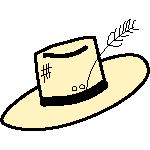THOSE AMAZING, BRILLIANT, BEAUTIFUL, SUPER-EFFICIENT "MAGICAL LIGHT MACHINES" - Pictured and alluded to above, these are the words I use to describe the multi-prism glass lenses first made by Augustin Fresnel in France in the 1820s. They were soon in use in lighthouses throughout Europe, and in all U.S. lighthouses by the time of the Civil War. Prior to the introduction of these lenses, lighthouses had many individual oil lamps, as many as fifteen or twenty at a major seacoast light. Not only did these consume a tremendous amount of oil, but they weren't all that bright, and couldn't be seen from very far away. Fresnel's lens required only a single lamp, thus saving both lots of fuel and lots of labor, and the prisms of the lens magnified and redirected the light source into horizontal beams of light that reached far out over the water. They truly revolutionized lighthouses. If you get a chance to visit a lighthouse or a museum with a Fresnel lens, you'll also realize how simply beautiful they are too.
These lenses came in several sizes. The larger ones, referred to as 1st-Order, were used at seacoast sites where they needed to be seen at the greatest distance. Most Great Lake sites used mid-size, or 3rd-Order lenses. An "inbetween size", called a "Third and a half" was also common at Great Lakes sites. Smaller, 5th and 6th-Order lenses were used on piers, breakwaters, and along our rivers. Several firms in Paris, France, were the only ones making these lenses for many years, and thus most American lighthouses had/have French-made lenses.
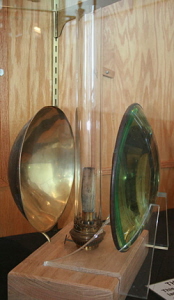 |
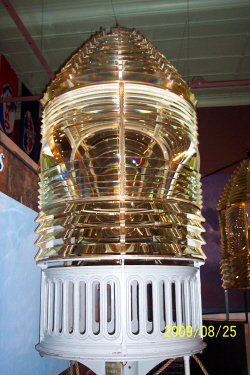 |
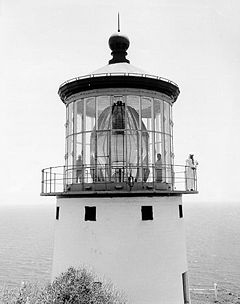 |
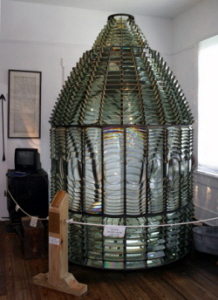 |
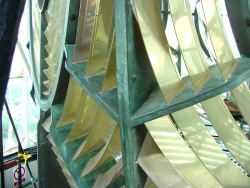 |
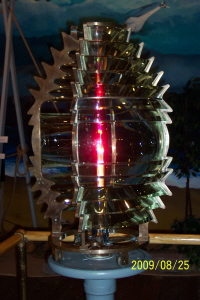 |
The top leftmost photo shows a type of oil lamp used in lighthouses prior to the invention and adoption of Augustin Fresnel's lens. A polished reflector behind the lens helped to direct the light from the lamp outward. The other photos show several types of Fresnel lenses, including the "Hyper-Radiant" one at the Makapu'u Lighthouse in Hawaii, which is the largest lens ever used in a U.S. lighthouse. Some lenses were "fixed", they did not turn. Those that rotated have circular "bulls-eye" lens sections. As the lens rotated around the light source, and as each "bulls-eye" passed between the light and the eye of the viewer, it gave the appearance of a bright flash. The timing between apparent flashes would let a mariner know exactly which lighthouse he was viewing. All lighthouses have something different about the appearance of their lights - known as the lighthouse's "characteristic." Otherwise mariners would not know which one was which in the dark. Some blink, some flash, some are different colors, some change colors, some are just big and bright.
Probably the most well known firm of French lens makers was HENRY-LEPAUTE (Le-Po-tay) of Paris. Many sources consistently list this firm as Henry Lepaute, or as Henry LePaute, as if Henry were a first name and Lepaute a surname. This is incorrect. Augustin Michael Henry, whose family was a major clock making family in France, began to work with Augustin Fresnel in 1825, designing the clockworks that would power the revolving lenses for lighthouses. He continued working with the Fresnel brothers supplying clockworks and later the lenses themselves, and opened his own factory in 1838. Augustin Henry's mother's maiden name was Paute. Her brothers were the Royal clockmakers to the French King from the 1750s. In 1854, Henry requested and received permission to add his mother's maiden name to his, changing his last name and that of the company to Henry-Lepaute, no doubt to further associate himself and his company with the prestigious name of the great clockwork company of the Pautes.
Some other French lens makers of note are: Louis Sautter of Paris (Maker of the first fixed Fresnel lens used at Navesink) Francois Soleil, and M.Tabouret of Paris; Sautter, Lemonier, et Cie of Paris; Barbier and Fenestre of Paris; Barbier Bernard & Turenne of Paris.
The earliest prisms were made of lead crystal glass, but this was found to chip easily. Such chips are apparent on the thin edges of many surviving lenses. Sodium was added to the glass when it was made, and the new product was called "crown glass". It has a slight greenish hue, but is much less likely to chip.
Most of the major early manufacturers of Fresnel lenses were French firms, and thus the vast majority of such lenses installed in American lighthouses were made in France. An English firm by the name of CHANCE BROTHERS, of Birmingham, was making these lenses by the late 1850s, and displayed Fresnel lenses in 1867 at an Exposition in Paris. Almost all lenses in England, Ireland, Scotland, Wales, Canada, and other parts of the former British Empire were made by this firm. Chance Brothers lenses are found in some U.S. lighthouses. Wilhelm Weule also made these lenses in Germany - I'm not sure how early, nor if any were in use in the U.S. As lighthouses were found worldwide, there were most likely other makers in other countries.
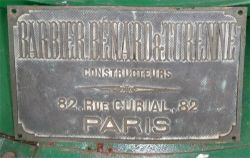 |
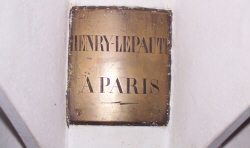 |
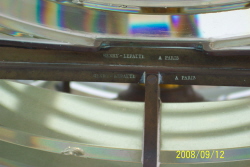 |
The left two photos above are of the manufacturer's name plate, usually found on the pedestal that supports the lens. The right photo is of the Henry-Lepaute markings on the brass frame pieces of a lens of that firm's manufacture.
By the early 1900s, the Lighthouse Service was urging U.S. glassmakers to produce Fresnel lenses for lighthouses. One of the few American firms to do so was the MACBETH-EVANS Company of Pittsburgh PA. They built some smaller (3rd Order or less) lenses, many of which were installed in Great Lakes lighthouses. A number of American companies, notably Corning Glass of New York, also manufactured small Fresnel-style lenses for buoys, railroad signals, and vehicle applications. (Look at the tail-light on your own vehicle today. It is a Fresnel lens.) By this time however, the greatest lighthouse-building period in U.S. history was over, so in fairness to American glass producers, the market just wasn’t there.
